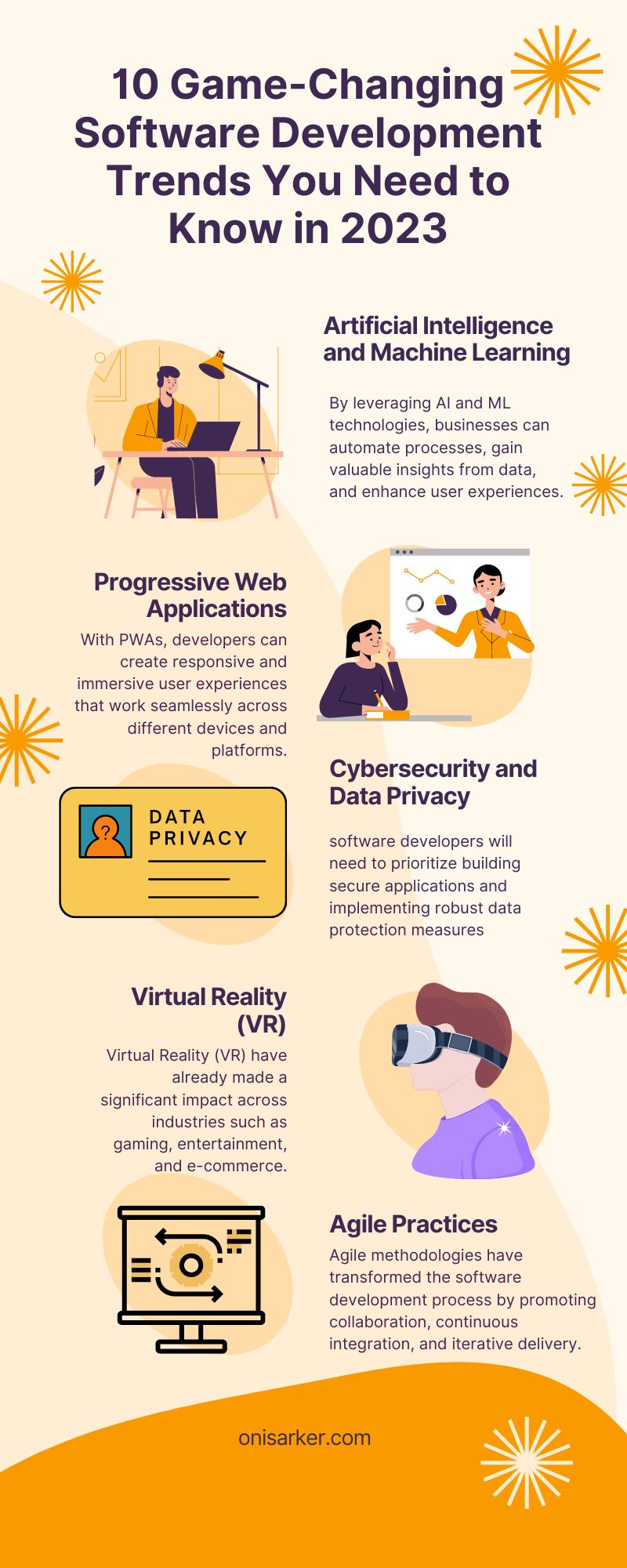10 Game-Changing Software Development Trends You Need To Know in 2023
Embracing these trends enables developers to stay competitive, drive innovation, and deliver cutting-edge solutions in the fast-evolving software development landscape.
Join the DZone community and get the full member experience.
Join For FreeIn the fast-paced world of technology, staying ahead of the curve is crucial for software developers and businesses alike. To maintain a competitive edge, it is essential to be aware of the latest trends and advancements in the field of software development. In this comprehensive article, we will explore the top 10 game-changing software development trends that you need to know in 2023. By embracing these trends, you can enhance your skills, deliver cutting-edge solutions, and drive innovation in the industry.
1. Artificial Intelligence and Machine Learning
Artificial Intelligence (AI) and Machine Learning (ML) continue to revolutionize the software development landscape. From predictive analytics to natural language processing, AI-powered solutions are becoming increasingly prevalent. In 2023, we can expect a surge in AI and ML adoption, enabling developers to build intelligent applications that can learn, adapt, and make informed decisions. By leveraging AI and ML technologies, businesses can automate processes, gain valuable insights from data, and enhance user experiences.
2. Internet of Things (IoT)
The Internet of Things (IoT) has been transforming various industries, and its impact will only continue to grow in 2023. As more devices become connected, software developers need to focus on creating IoT-compatible applications and platforms. IoT integration enables businesses to collect, analyze, and utilize data from interconnected devices, leading to improved efficiency, enhanced automation, and seamless connectivity.
3. Progressive Web Applications (PWAs)
Progressive Web Applications (PWAs) offer the best of both worlds, combining the reach of web applications with the capabilities of native apps. With PWAs, developers can create responsive and immersive user experiences that work seamlessly across different devices and platforms. In 2023, the demand for PWAs is set to rise as they eliminate the need for separate development for each operating system, reduce development costs, and provide offline capabilities.
4. Low-Code and No-Code Development
In an era of rapid digital transformation, businesses are looking for ways to accelerate application development while minimizing costs. This has given rise to the popularity of low-code and no-code development platforms. These platforms enable developers to build robust applications with minimal coding requirements, allowing for faster development cycles and increased productivity. In 2023, we can expect a surge in the adoption of low-code and no-code platforms, empowering both developers and citizen developers to create innovative solutions.
5. Cybersecurity and Data Privacy
Cybersecurity, as well as data confidentiality, are now top priorities due to the frequency and sophistication of cyber threats. In 2023, software developers will need to prioritize building secure applications and implementing robust data protection measures. From secure coding practices to regular security audits, developers must ensure that their applications are resilient against cyberattacks and comply with data privacy regulations.
6. Blockchain Technology
Blockchain technology, originally known for its association with cryptocurrencies, has evolved beyond the financial sector. In 2023, we can expect to see widespread adoption of blockchain in various industries, including supply chain management, healthcare, and voting systems. By leveraging blockchain, developers can create decentralized, transparent, and tamper-proof applications that enhance security, traceability, and trust.
7. Augmented Reality (AR) along with Virtual Reality (VR)
Augmented Reality (AR) and Virtual Reality (VR) have already made a significant impact across industries such as gaming, entertainment, and e-commerce. In 2023, we can anticipate further advancements in AR and VR technologies, expanding their applications beyond the consumer realm. Software developers will play a crucial role in creating immersive and interactive AR/VR experiences that enhance training, education, and visualization in various sectors.
8. Edge Computing
With the proliferation of Internet-connected devices and the increasing demand for real-time data processing, edge computing has emerged as a critical trend. In 2023, edge computing will gain further prominence, enabling developers to bring computation and data storage closer to edge devices. This decentralized approach reduces latency, improves response times, and enables applications to function reliably even in low-bandwidth environments.
9. Quantum Computing
Although still in its early stages, quantum computing holds immense potential for solving complex problems that are beyond the capabilities of traditional computing systems. In 2023, we can expect further advancements in quantum computing research and the development of quantum software frameworks. As quantum computing evolves, software developers will need to acquire the necessary skills to harness its power and explore its applications in diverse domains.
10. DevOps and Agile Practices
DevOps and Agile methodologies have transformed the software development process by promoting collaboration, continuous integration, and iterative delivery. In 2023, these practices will continue to be pivotal in ensuring efficient software development cycles and a faster time to market. Embracing DevOps and Agile approaches allows developers to enhance collaboration, streamline processes, and deliver high-quality software that meets evolving user needs.
Conclusion
As software development continues to evolve rapidly, staying updated with the latest trends is vital for success. By incorporating these 10 game-changing software development trends into your skillset and projects, you can position yourself as a frontrunner in the industry. Embrace innovation, leverage cutting-edge technologies, and deliver transformative solutions that meet the evolving demands of businesses and users in 2023 and beyond.
Published at DZone with permission of oni sarker. See the original article here.
Opinions expressed by DZone contributors are their own.


Comments